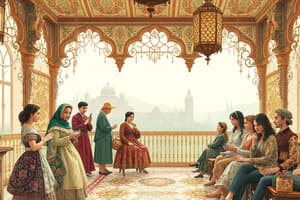Podcast
Questions and Answers
Countercultures are minority cultures that directly oppose the dominant culture.
Countercultures are minority cultures that directly oppose the dominant culture.
True (A)
Identify which of the following is an example of a counterculture.
Identify which of the following is an example of a counterculture.
- Neighborhood watch programs
- Professional associations
- Biker gangs (correct)
- Local community groups
Based on our discussion in this course, high culture is defined as the culture of the majority.
Based on our discussion in this course, high culture is defined as the culture of the majority.
False (B)
What is cultural capital, according to Pierre Bourdieu?
What is cultural capital, according to Pierre Bourdieu?
Mass culture provides individuals with a high degree of agency in their cultural choices.
Mass culture provides individuals with a high degree of agency in their cultural choices.
Tunwase was invited to a dinner at Evelyn's family house. He was seen to be double-dipping chips. Because Evelyn is from a classy Westen family, Tunwase was presumed to have violated some practices that have to do with___________
Tunwase was invited to a dinner at Evelyn's family house. He was seen to be double-dipping chips. Because Evelyn is from a classy Westen family, Tunwase was presumed to have violated some practices that have to do with___________
Positive sanctions are used to punish individuals who violate cultural norms.
Positive sanctions are used to punish individuals who violate cultural norms.
What is cultural relativism primarily concerned with?
What is cultural relativism primarily concerned with?
Which term describes the phenomenon of judging other cultures by the standards of one's own culture?
Which term describes the phenomenon of judging other cultures by the standards of one's own culture?
Eurocentrism often highlights important non-European developments in history.
Eurocentrism often highlights important non-European developments in history.
Based on the course material, ________ is an example of actual culture.
Based on the course material, ________ is an example of actual culture.
It can be argued that cultural globalization leads to the isolation of cultures.
It can be argued that cultural globalization leads to the isolation of cultures.
Flashcards are hidden until you start studying
Study Notes
Culture in Context
- Culture is a system of behaviors, beliefs, knowledge, practices, values, and material items that shape a people's way of life.
- Cultures are dynamic and change over time.
- Cultures are contested, with disagreements regarding who and what belongs to a particular culture.
- Authenticity is a point of contestation within cultures.
Components of Culture
- Tangible components of culture include concrete items or symbols that represent the culture, such as clothing, housing, and food.
- Intangible components of culture are symbolic and abstract elements that can only be interpreted, such as language.
Cultural Typology
- Cultures can be categorized along two central oppositions:
- Dominant culture vs. subculture and counterculture
- High culture vs. popular culture and mass culture
Dominant Culture versus Subculture and Counterculture
- Dominant culture is the culture that, through its political and economic power, imposes its values, language, and behaviors on a society.
- Minority cultures fall outside the cultural mainstream.
- Countercultures oppose the dominant culture, often expressed through clothing styles or sexual norms. (e.g., hippies, biker gangs, alternative fashion)
- Subcultures differ from the dominant culture but don't directly oppose it. (e.g., groups organized around occupations or hobbies)
High Culture versus Popular Culture
- High culture represents the culture of the elite, associated with the arts and requiring "cultural capital" – skills and knowledge needed to acquire sophisticated tastes associated with high culture.
- Popular culture represents the culture of the majority, especially those without power (e.g., working class, less educated, women, and racialized minorities).
- Cultural studies explore the significance and meanings conveyed in popular culture.
Popular Culture and Mass Culture
- Mass culture refers to people with little agency in the culture they consume, often dictated by companies in power.
- A key distinction exists between popular culture and mass culture, with popular culture allowing for greater individual agency and creativity within the cultural framework.
Simulacra and Mass Culture
- Simulacra are stereotypical cultural images produced and reproduced by media and scholars, often considered more real than reality. (e.g., Inuit represented through igloos and kayaks)
Decipherment and Reading in Popular Culture
- Decipherment seeks to understand the intended meaning or purpose behind cultural products.
- Reading involves individuals interpreting cultural products and resources in their own way, independently of the creators' intended meaning.
Cultural Norms
- Norms are rules or expectations of behavior within a group, society, or culture.
- Norms can be contested based on ethnicity, race, gender, and age.
- Norms are expressed through ceremonies, dress, and other cultural practices.
Sanctions
- Sanctions are rewards or punishments for behavior.
- Positive sanctions are rewards for "doing the right thing." (e.g., smiles, high fives, bonuses)
- Negative sanctions are reactions designed to deter norm violations. (e.g., glares, eye rolls, parking tickets, library fines)
Folkways, Mores, and Taboos
- Folkways are norms governing everyday matters, weakly sanctioned when violated. (e.g., double-dipping chips)
- Mores are more serious norms, formalized and with heavier sanctions for violations. (e.g., stealing, rape)
- Taboos are deeply ingrained norms, causing disgust or revulsion at the mere thought or mention. (e.g., incest, child pornography)
Culture Symbols
- Symbols are cultural items with significance for a culture or subculture.
- Tangible symbols can include material objects, such as the maple leaf or niqab.
- Intangible symbols can include non-material objects like songs or events (e.g., seal hunt, Canadian anthem).
Values
- Values are standards used to describe abstract qualities (goodness, beauty, justice) and evaluate behavior.
- Ideal culture represents what people believe in. (e.g., environmentalism)
- Actual culture reflects reality. (e.g., driving large SUVs)
Ethnocentrism
- Ethnocentrism is judging other cultures based on one's own culture as the standard.
- Ethnocentrism often stems from lack of knowledge or ignorance.
- Ethnocentrism has played a role in colonization efforts by powerful nations.
Eurocentrism
- Eurocentrism involves viewing the world from a European perspective and assuming the audience shares or desires that perspective.
- Eurocentric perspectives often emphasize European advancements while downplaying or ignoring non-European developments.
Reverse Ethnocentrism
- Reverse Ethnocentrism involves embracing the superiority of another culture over one's own. (e.g., second-generation migrants detaching from their original cultural values)
Cultural Globalization
- Cultural globalization refers to the intensified and expanded flow of culture across the globe.
- Concerns exist about the "Americanization" of the world and the potential for unidirectional cultural flow.
Cultural Relativism
- Cultural relativism involves understanding aspects of another within their social, historical, and environmental context.
- We should avoid using our own cultural standards to judge others.
Cultural Relativism versus Presentism
- Cultural relativism allows for judging historical figures within their own time, not by today's standards.
- Presentism involves judging historical figures by today's standards.
Sociolinguistics
- Sociolinguistics studies language as part of culture.
- Language is crucial for communication and cultural transmission.
- Sociolinguistics examines language's relationship to factors like race, ethnicity, age, gender, and region.
Dialect as a Sociological Term
- Dialect is a variety of a language with distinct pronunciation, vocabulary, and grammar.
- Dialects are often evaluated based on social and linguistic factors, creating perceptions of proper/improper or casual/formal language.
Studying That Suits You
Use AI to generate personalized quizzes and flashcards to suit your learning preferences.




